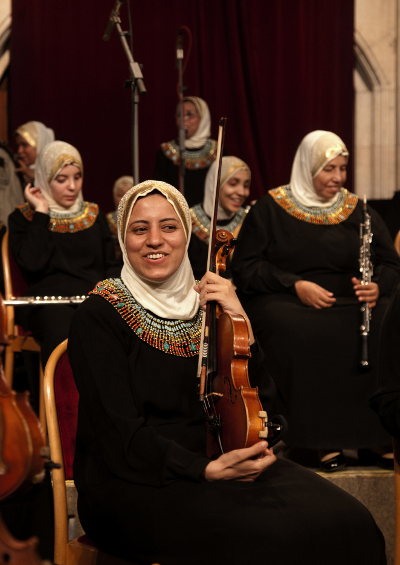Blind Women Make Music in Egypt
A government program in Egypt helps educate and train young blind woman as classical musicians.
November 22, 2014

Fernando Moleres is an award winning freelance photographer. Moreles often photographs stories related to human rights issues and current events. He approaches documentary photography as an art and instrument to help explore issues across the world.
Shaimaa Yehia, 28, is a violinist with the Al Nour Wal Amal orchestra, a 40-strong ensemble of blind women from Cairo. The orchestra, which plays a full range of string and wind instruments, is run by the Al Nour Wal Amal Association, an Egyptian non-governmental organization that takes in blind girls from Cairo’s poor.
The association was founded in 1954 and its name means light and hope. It gives the girls a formal education in the mornings, emphasizing literacy and vocational training, and teaches them music in the afternoons. Shaimaa entered when she was seven. In her first year, she was taught to read and write words and musical notes in Braille.
The following year, aged eight, she chose the violin as her instrument. She then spent five hours a day practicing and just one year later became a member of the association’s junior orchestra. At 12, she entered the senior orchestra, since then travelling with it across Europe, to North America and to Australia.
Unable to read music as they play, the orchestra’s musicians memorize it, typically carrying around 45 pieces in their heads at any one time, among them works by the Egyptian composer, Ahmed Aboeleid, and classical European pieces by Mozart, Brahms, Strauss, Tchaikovsky and others.
Text and photographs by Fernando Moleres
 Enlarge Members of blind women chamber orchestra Al Nour wal Amal (Light & Hope) making up before a performance in Segre, France.
Enlarge Members of blind women chamber orchestra Al Nour wal Amal (Light & Hope) making up before a performance in Segre, France. Enlarge Members of blind women chamber orchestra Al Nour wal Amal (Light & Hope) during the concert in the Manoel Theatre, Malta.
Enlarge Members of blind women chamber orchestra Al Nour wal Amal (Light & Hope) during the concert in the Manoel Theatre, Malta. Enlarge Members of the Al Nour Wal Amal orchestra take a break during a concert at the Manoel Theatre in Malta’s capital, Valletta.
Enlarge Members of the Al Nour Wal Amal orchestra take a break during a concert at the Manoel Theatre in Malta’s capital, Valletta. Enlarge Shaimaa with some members of blind women orchestra Al Nour wal Amal shopping after the performance during a tour in Malta
Enlarge Shaimaa with some members of blind women orchestra Al Nour wal Amal shopping after the performance during a tour in Malta Enlarge Shaimaa on her way to vote in a national election. As well as being a violinist, she also has a university degree in English, which she teaches for a living.
Enlarge Shaimaa on her way to vote in a national election. As well as being a violinist, she also has a university degree in English, which she teaches for a living. Fernando Moleres is an award winning freelance photographer. Moreles often photographs stories related to human rights issues and current events. He approaches documentary photography as an art and instrument to help explore issues across the world.
Fernando Moleres is an award winning freelance photographer. Moreles often photographs stories related to human rights issues and current events. He approaches documentary photography as an art and instrument to help explore issues across the world.The Other Hundred is a unique photo-book project (order here) aimed as a counterpoint to the Forbes 100 and other media rich lists by telling the stories of people around the world who are not rich but who deserve to be celebrated.
Its 100 photo-stories move beyond the stereotypes and cliches that fill so much of the world’s media to explore the lives of people whose aspirations and achievements are at least as noteworthy as any member of the world’s richest 1,000.

Selected from 11,000 images shot in 158 countries and submitted by nearly 1,500 photographers, The Other Hundred celebrates those who will never find themselves on the world’s rich lists or celebrity websites.
